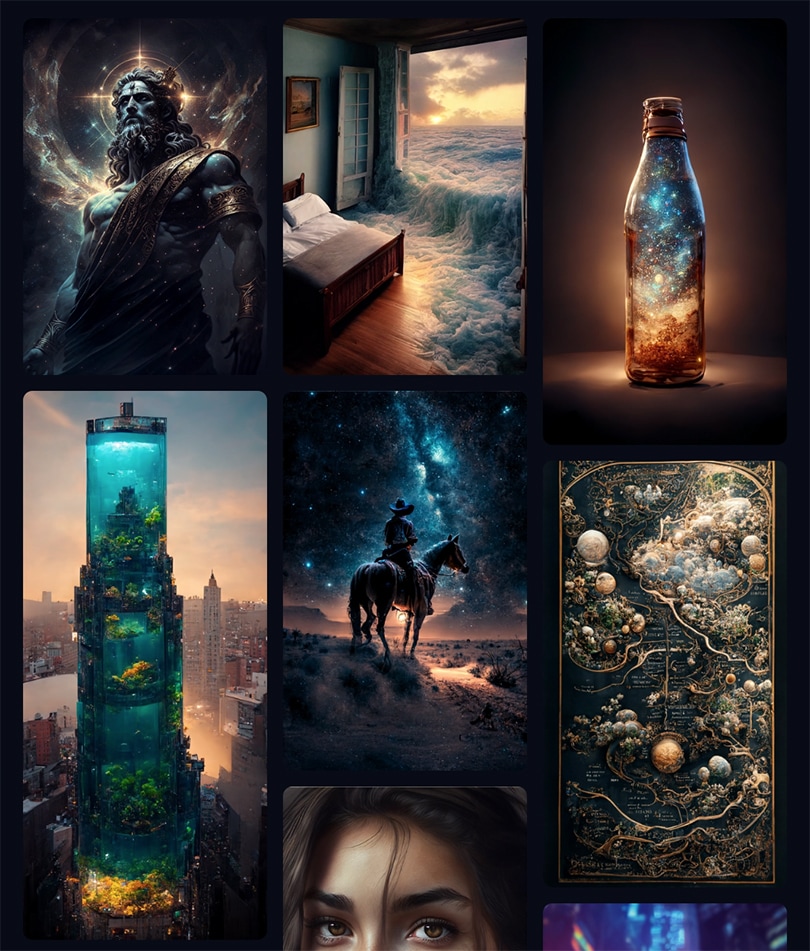Artificial Intelligence (AI) has become a hot topic in the business world, with many organisations eager to embrace this exciting technology and reap the benefits it can offer. However, despite the potential for significant ROI, the adoption of AI also brings with it a range of risks and challenges.
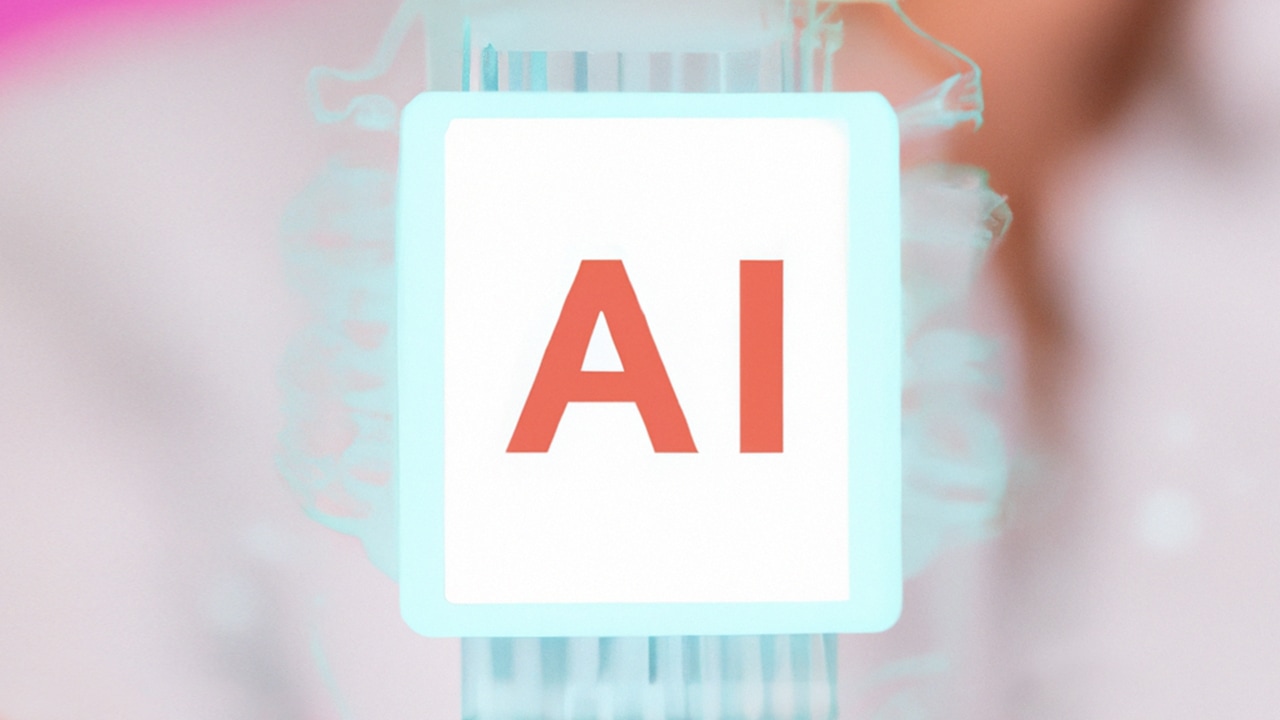
In this article, we take a closer look at the opportunities and risks associated with using AI in your business and explore how you can employ AI to save time and money. All while mitigating potential risks.
You’ll learn about the limits and drawbacks of AI and also how the latest AI-powered tools can provide the answers, inspiration, and time savings you need to get more done in your business.
So, let’s get into it!
AI is everywhere
AI technology has made significant progress in the last couple of years and has featured heavily in our timelines and newsfeeds recently. As a result, it has become increasingly important in many industries and aspects of modern life.
Most people have some awareness of the main areas of AI research and application, which include:
- Machine Learning as used in image recognition
- Natural Language Processing as used for chatbots
- Computer Vision as used in self-driving cars and facial recognition software
- Robotics as used in manufacturing, construction, agriculture, logistics, healthcare, transport, law enforcement, disaster response, and across many other applications
- AI Ethics as used in AI-powered image and content generation tools
A growing number of people are already using AI tools like ChatGPT, DALL·E 2, and Midjourney, among others, in their daily work and personal lives.
And there has been a sudden spike in businesses offering AI-powered services, wrapping around tools like ChatGPT. These businesses make AI more accessible and better suited to specific business tasks (like generating images and content for social media, for example). We’ll share some examples later in this article.
What can AI do to help me?
AI is ready to go to work. In fact, it generated the title, image, and introduction for this article! Okay, so we had to tweak things and make the content our own (and we’ll explain why later). Still, AI tools did the heavy lifting and inspired us while we sat back and enjoyed a nice coffee (we had to make that ourselves – for now).
Today’s AI-powered tools are surprisingly mature, usable, reliable, accurate, capable and incredible value for money. Here are just some things AI can help you with:
- Transcribe, organise, and share live meetings or audio files
- Generate inspiring mood boards for clothing design/textiles, interior design, graphic design, vehicle wraps - anything, really!
- Writing content for pretty much any purpose
- Communicate with customers on your behalf
- Provide answers to nearly any question you might have on any subject
- Generate custom stock photography for social media and websites
- Produce concepts for logos, websites, presentations, book covers, and other designs to inspire and kick-start creative projects
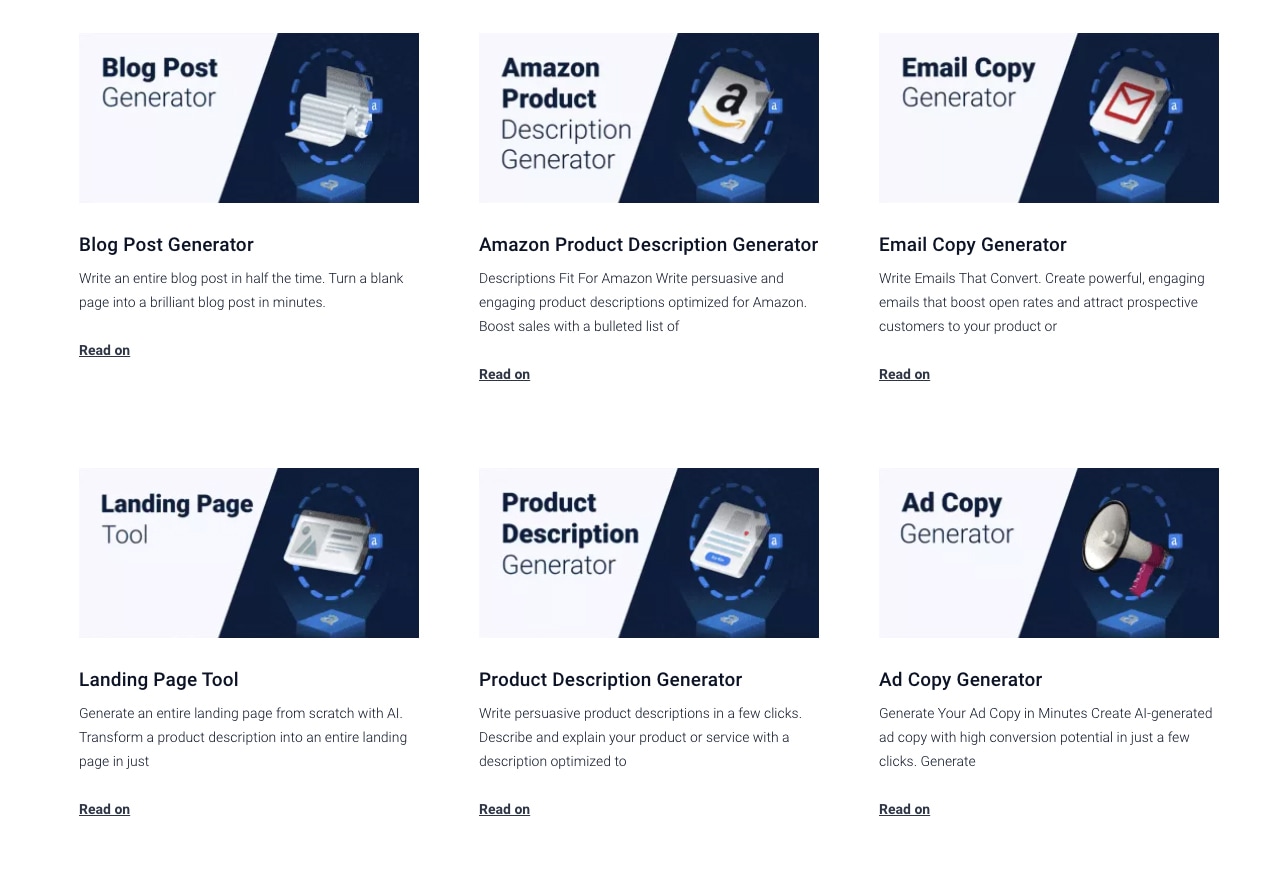
Important: We want to make it clear that AI can never replace the people that create original artwork, content, designs - they're the ones with real human connection. They're the ones Instead, we ask you to think of AI as a knowledgeable and efficient virtual employee that works 24/7 to provide inspiration, information, and automation.
Article sections:
- Content
- Detect plagiarism
- Consumer research
- Images
- Meetings
- Inspiration
- Presentations
- Naming
- Logos and design
- Marketing
- Sales
- Other uses
Content
One of the most common applications for AI in businesses today is generating content for blogs, websites, marketing, advertising, social media, and emails, among other common applications.
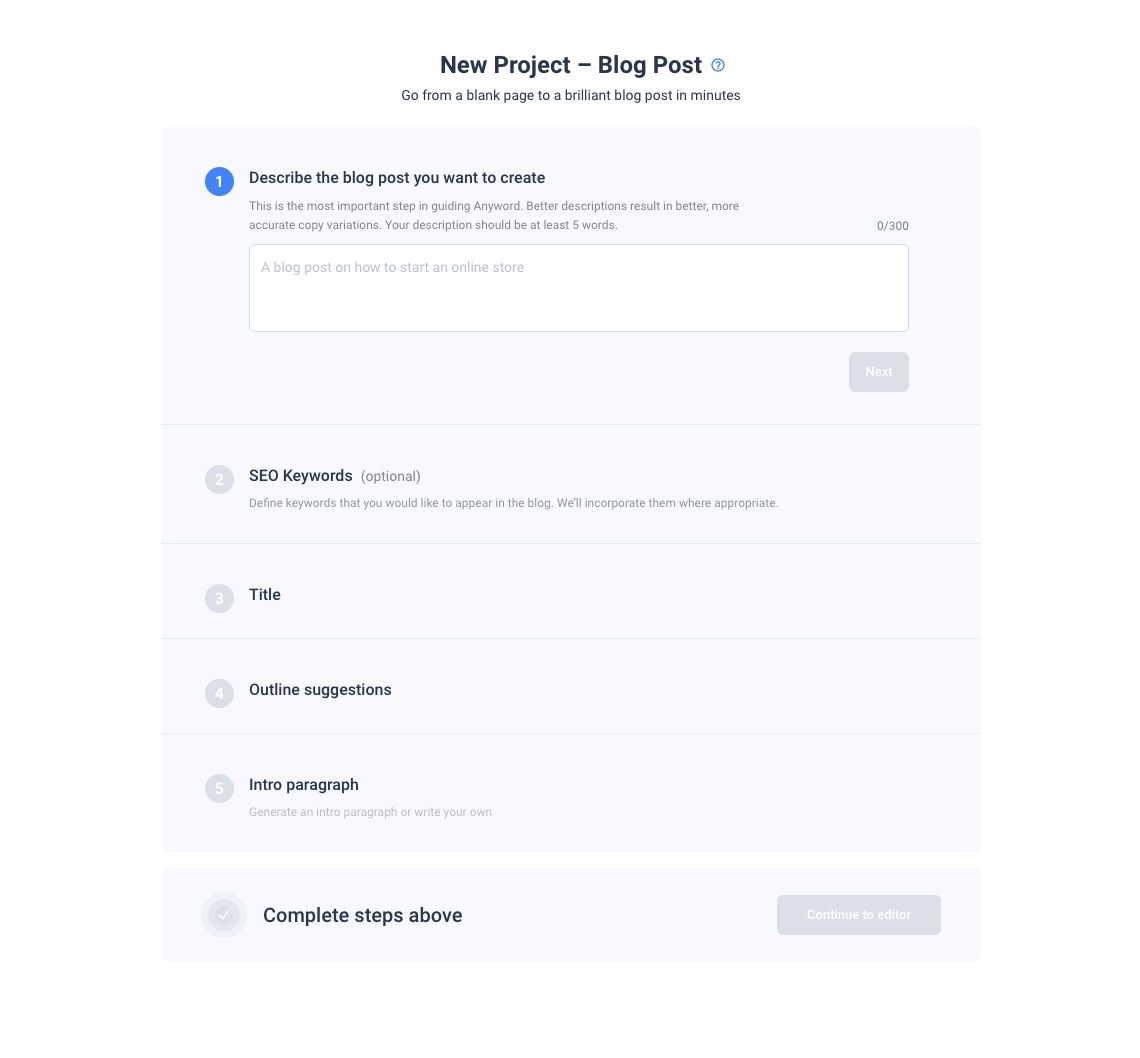
AI tools and services for generating content include:
You can use these and other content-generating tools for:
- Generating title ideas or suggesting interesting topics for your next blog post
- Suggesting an outline or structure for your document based on a title or general idea
- Writing a first draft of a sales email, advertisement, job description, product description, or website copy to give you a head-start
- Rewriting content to improve Search Engine Optimisation
- Responding automatically to common questions on social media, email, or through your customer support system
And here’s why AI works so well for generating content:
- AI will never run out of ideas
- AI has consumed incredible amounts of information about nearly every subject you can think of
- Unlike us, AI doesn’t feel the pressure of a blank page or get writer’s block
- AI speeds up the content creation process significantly
- AI can automate repetitive content and never get tired or complain
The benefits of using AI to generate content are clear, but you will still need to be heavily involved in the process. You need:
- to decide what your content is going to be about
- a clear understanding of your audience, including the user need or goal that your content solves
- an understanding of how your content adds value to your audience
- the business goals you’re aiming to meet with your content
- an overall plan and structure for your content
- an idea of where your content fits in terms of your brand guidelines, content style guide, marketing and digital strategies, and overall business plan
- references, quotes, stats, and other evidence to back up what your content is all about
- time to edit the rough draft generated by AI to make it yours, fine-tune it for your specific audience and unique business needs, and avoid copyright and plagiarism problems
- time to think and assess your content until you believe it’s ready for your audience
- tools like Grammarly and Hemingway to check for spelling, grammar, and readability
- someone to proofread before publishing
Important: As you can see, AI can assist you in the content writing process. However, avoid using IT to write an entire article. Publishing an AI-generated blog article or web page without your involvement in the creative process is against Google’s guidelines. It will be considered spam content, which could penalise your entire website in the search engine rankings.
Detect plagiarism
The downside of AI tools generating content every minute of every day is that people could rely entirely on this technology without giving their input to make their content unique, plagiarism-free, and suitable for their specific audience.
Thankfully, tools like Originality exist to identify plagiarism and detect if AI tools were used to create the content.
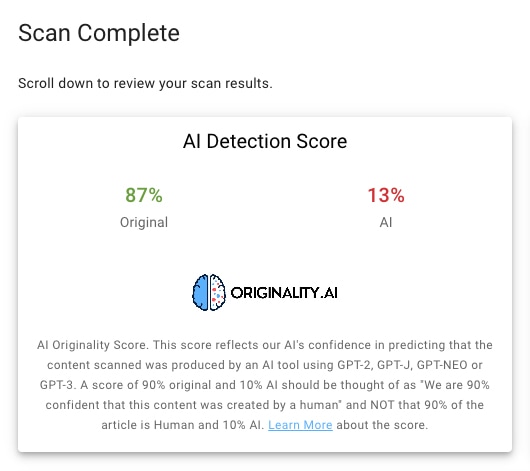
Consumer research
You can use AI for consumer research in your business in several ways. Here are just a few examples that could save you significant time and money:
- gain insight from customer data, sales data, website traffic data, and other types of data relevant to your business
- predict which customers are most likely to cancel or move elsewhere or which products are likely to sell well in the future
- extract insights from customer feedback, social media posts, and other types of unstructured text data
- identify patterns and track trends from visual content such as product images or social media posts
- Use chatbots or virtual assistants to conduct surveys and gather feedback from customers
To use AI for research in your business, you will need to have a clear consumer research question or objective, and access to relevant data. You may also need to work with a data scientist or AI expert to help you develop and implement AI algorithms tailored to your specific needs.
Using AI to perform consumer research is a good example of how this technology can work for us but requires human input to be truly effective.
Translations
AI tools like ChatGPT and Jasper can help you translate content from English into other languages. For example, Jasper can read and write content in over 29 languages. At the time of writing, ChatGPT supports translations for the following languages:
- English
- Arabic
- Chinese (Simplified and Traditional)
- Dutch
- French
- German
- Hindi
- Italian
- Japanese
- Korean
- Polish
- Portuguese
- Russian
- Spanish
- Swedish
- Turkish
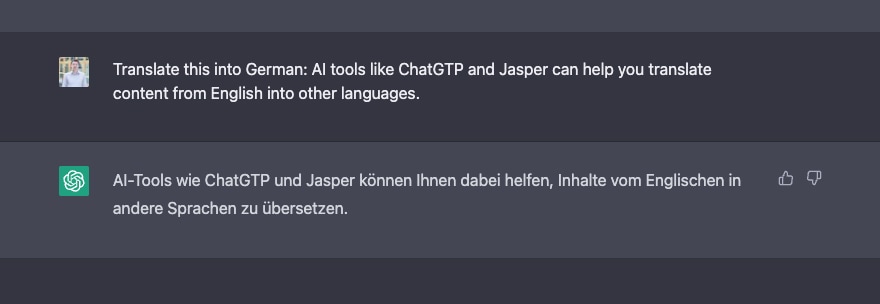
Meetings
AI-powered tools like Fireflies, Avoma, and Otter can help you record, transcribe, search, and analyse voice conversations from online meetings and audio recordings. They typically work by attending meetings with you, capturing the video and audio, and generating transcripts in minutes.
This is a great time-saver when you need to quickly search for and share important discussion points and actions from your meetings. You also get a clear and accurate text transcription of the entire meeting to read.
Inspiration
Sometimes inspiration doesn’t come easy. AI is an incredible resource for generating ideas from a simple text prompt. AI-generated ideas come in many forms:
- Images and artwork
- Music and sounds
- Topics for content
- Short stories or poems
- Recommendations for new products or books
- Names for products, businesses, books, etc
Images
While AI can never replace the original work of designers and artists, you can use powerful tools like DALL·E 2, Midjourney, Shutter Stock, stockimg.ai, Craiyon, and many others to generate images for your business.
What are the benefits of generating images with AI?
- If you can imagine it, AI can generate it
- There are no limits (within reason and the law, of course)
- Complex images are generated in minutes
- Most tools generate a few versions for you to choose from
- Credits are usually relatively inexpensive, so you can save money compared to some stock photography websites or hiring a photographer
- Some tools can produce imagery using the format and dimensions required by social media platforms, saving you time and money
- You can usually specify dimensions suitable for your particular need
- There is a vast range of different styles available (which we talk about later in this guide)
- You can bring the images you’ve generated into creative discussions as examples of what you need from designers, illustrators, or photographers
What are the drawbacks?
- AI has difficulty producing images that contain text (for a logo, poster or website design concept, for example)
- The tools won’t generate images that contain protected symbols, brands, or logos
- Some parts of the image may not be perfect (hands, for example)
- It takes time to learn how to write good text prompts and get the best results from the tools
- Sometimes during busy periods, the tools aren’t available
- AI tools don’t know your audience or brand, so the results may not be suitable
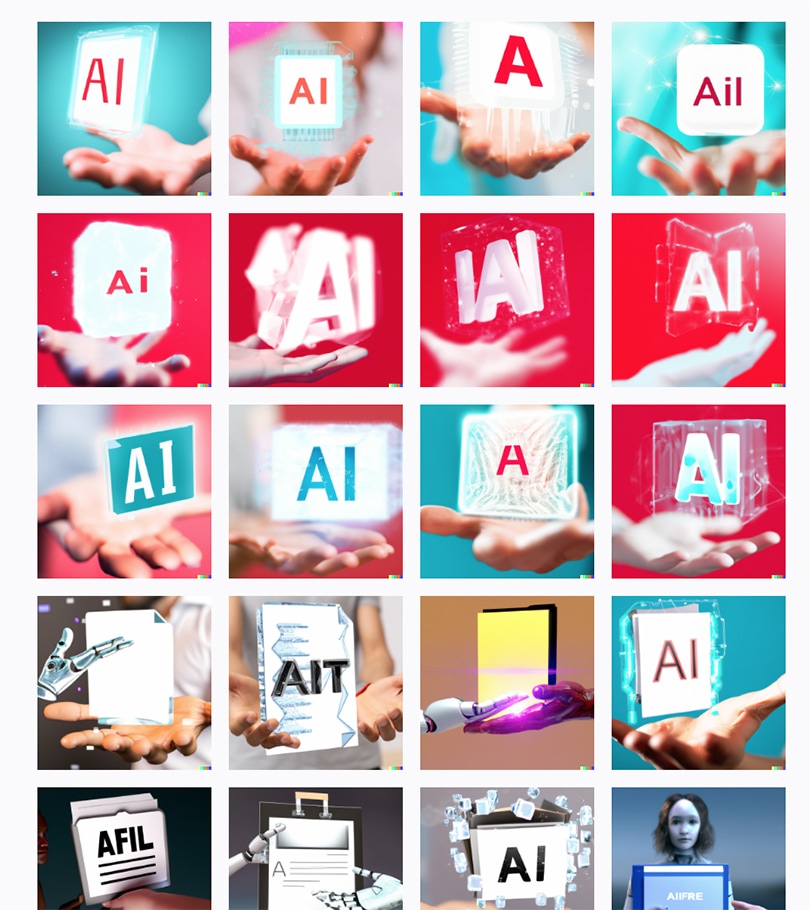
Image: Generating images for this article!
Presentations
Tools like SlidesAI, beautiful.ai, and presentations.ai can save you significant time creating a presentation. They can even write the outline and presentation content for you.
As with anything generated by AI for your business, be aware that, as intelligent as this technology is, it will never understand the needs of your business or target audience as well as a design or marketing professional could. And the results will reflect this. But, if you’re stuck for time, budget, or ideas (or all three!), these AI-powered presentation tools will surely come in handy.
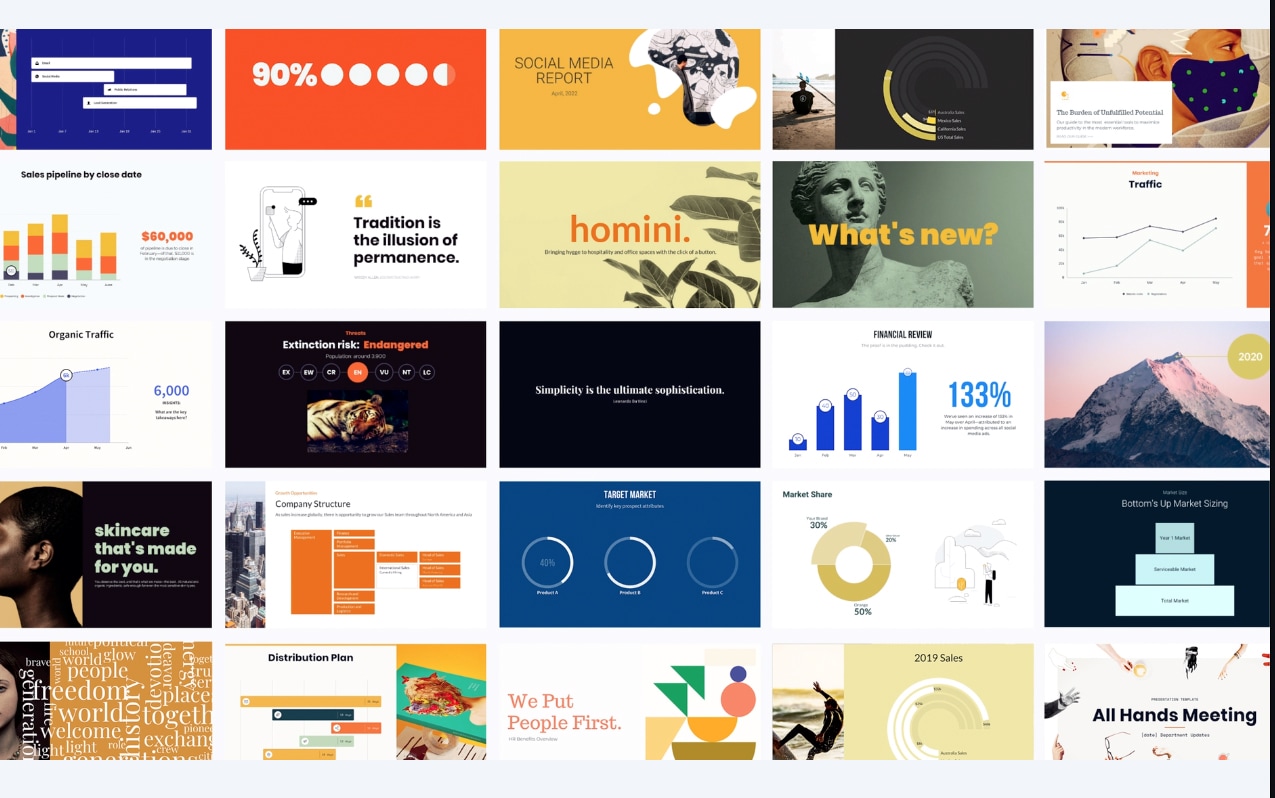
Naming
If you are ever stuck for a name for a new product or business, you can feed some general ideas or your elevator pitch into AI tools like ChatGPT and generate potential naming options.
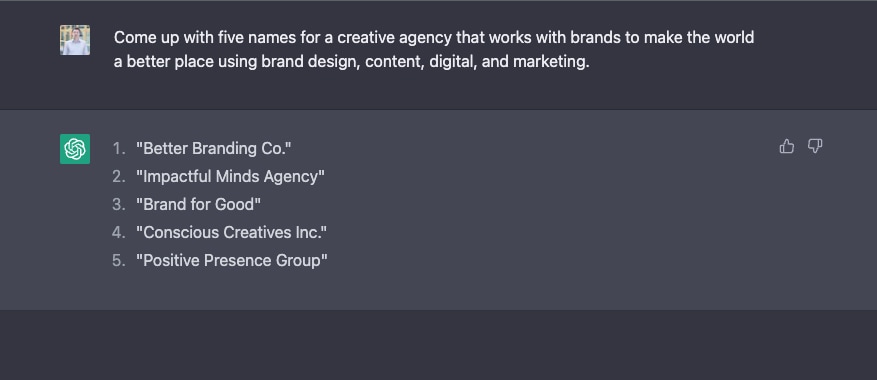
This process is ideal for ruling out some names and finding the right direction before approaching an agency like zen to take your project to the next stage.
Important: When naming a product, business, or any other legal entity, you must perform background checks on the name’s availability, look for trademarks, check registered company names on Company’s House, investigate competitors' websites, ensure domain names are available, and perform other essential checks. Contact us for help with naming.
Logos and design
Similar to naming ideas, AI can generate concepts for your new logo or website design. You can ask AI to design pretty much anything.
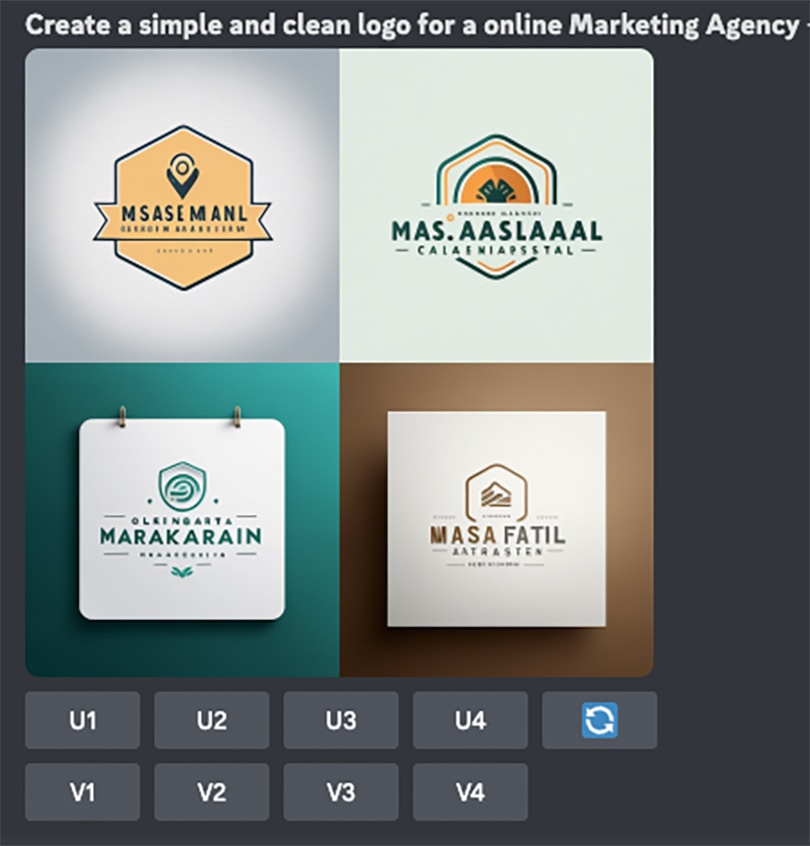
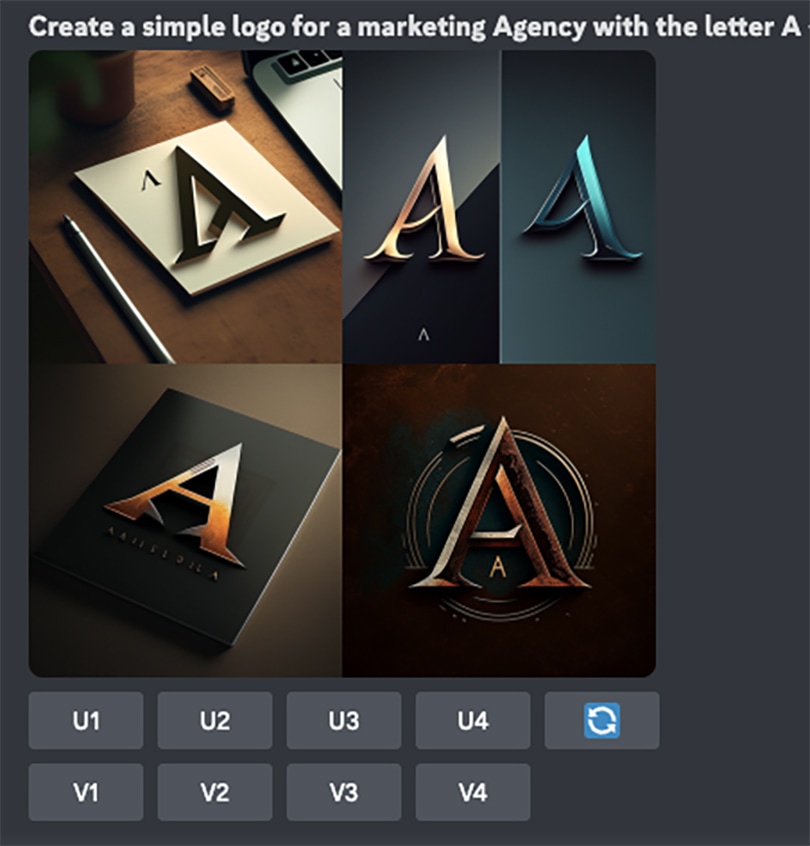
The usual caveats apply here. AI doesn’t know your business or audience and may not produce something suitable as a result. However, AI is useful for kick-starting discussions and starting the creative process. Think of the logos and designs it produces as a moodboard to establish the right visual direction for your business.
Marketing
In addition to content generation and social media applications of AI in marketing that we have already covered, you can use AI marketing tools like Smartly, Grammarly, and Levity to assist with your marketing in many ways:
- Marketing analytics
- Making predictions about campaigns and user behaviour
- Automating decisions and repetitive tasks
- Content generation
- Content quality analysis
- Personalised content
- Boosting campaign ROI
- Ad targeting and analysis
- Social media listening
- Brand monitoring
- Automated media buying
Sales
Applying AI to your sales processes means processing more data and gaining deeper insights into customer behaviour and buying habits. You can use AI tools like Salesforce Einstein, Exceed, and Drift to assist with your sales in many ways:
- Sales forecasting using predictive sales AI
- Lead scoring and prioritisation
- Lead nurturing
- Automating repetitive sales tasks
- Monitoring sales calls
Other uses
There are many other ways to use AI in your business to save time, money, and resources. Here are just a few:
- Decision-making
- Planning
- Time tracking
- Recording expenses
- Decoding complicated legal documents
- Organising your contacts
- Generating interview questions
- Writing better job descriptions
- Assessing job applications
- Writing code
How do I work with AI tools like ChatGPT?
Like many things in life, you only get out what you put in. Or Garbage In, Garbage Out, to use a common term in computing programming. The more detailed and specific you can be with your query, the better the results you’ll get back from AI tools like ChatGPT and Midjourney.
1. Get access
Visit the website of the AI tool you wish to use and sign up. Many tools have a free trial or free credits, so you can experiment before parting with any money. Some tools are completely free (for now), including ChatGPT and DALL·E 2.
2. Write a prompt
Most AI tools have a clear and obvious place to enter a prompt. The prompt is simply a text instruction for the AI, asking it to generate something.
- Our top tips for prompts:
- The length of your prompt should be equal to the complexity of what you need
- Get specific about the type of image or content you need
- Experiment!
- Start simple and then reference our tips below for advanced users
3. Generate corrections and refinements
If you’re not completely happy with the results of your initial prompt, you can refine it by changing the text or using a ‘regenerate’ option if the tool provides one. Some AI tools like Midjourney provide multiple options and the ability to select a variation for further experimentation.
Adding more detail to your prompt and being more specific helps to refine your initial results.
4. Personalise and humanise
Always take the time to personalise AI-generated content, fine-tuning it for your target audience and business needs.
Most businesses have brand and content guidelines that help inform their content and designs. Personalising content created by AI tools means customising it to reflect your brand values and applying your unique tone of voice and personality.
Visually, your brand will have defined colours and styles that should ideally play a part in any imagery associated with your business. Anything else will just create inconsistencies and confuse your audience.
5. Become an advanced user
Advanced users of AI tools like Midjourney and ChatGPT get the best results by writing better prompts and knowing how to make refinements to what the tools generate the first time around.
Write better prompts
Here are some examples of what you can specify in prompts for images:
- Display ratio: 16:9, 4:3, square, panorama, vertical
- Resolution: 4k, 8k
- Lighting: Golden hours, natural light, backlighting, hard light, soft light, reflections
- Styles: Cinematic, macro photography, tilt shift photography, long-exposure photography, film noir, pop art, minimalism, blueprint, schematic, wireframe, abstract
- Colours: Monochrome, stark contrasts, bright colours against a dark background, pastels
- Composition: Extreme close-up, unusual angles, negative space
- Engine: --v 4 (use version 4 of the generation engine, the newest version at the time of writing)
- Quality: --v 2 (values higher than the default of ‘1’ increase rendering time and use more credits)
Some of these are known as ‘style modifiers’ – special suffixes or phrases attached to specific words in the prompt to provide additional information to the AI about the desired appearance of your generated image.
Other things to consider when writing your prompt:
- Word order: Experiment with the order of words to see how it affects the results (‘table laptop’ will generate different results than ‘laptop table’, for example)
- Sensory details: sights, sounds, smells, and textures
- Focus object: Specific the focal point of your image
- Emphasis: Use a suffix to emphasise a word (for example, laptop::0.8 table::0.2 will produce an image that focuses on a laptop with only a bit of table showing)
What are the risks of using AI in your business?
Appropriateness
AI won’t always generate something appropriate for your business as it doesn’t know your audience and what they need and won’t remember if you do tell it.
Authenticity
Content and imagery generated using AI can lack the human touch and can be very obviously computer-generated. Authentic content and design will resonate better with your audience.
Accuracy
AI may occasionally generate inaccurate information or imagery that simply makes no sense to us humans. And some AI tools like ChatGPT have limited knowledge of the world and events after 2021 (at the time of writing). There will no doubt be regular updates to correct this.
Copyright
Most AI works with existing content and creations. Materials created by us mere mortal humans. Materials that have owners, licenses, trademark registrations, and copyright protection. Materials that can be detected by online tools.
Practicalities
AI doesn’t always supply the required format or completely understand your prompt, leading to wasted time and frustrations.
Bias
AI may also sometimes generate text that has a bias towards a particular outcome or group of people – people who may not be your target audience.
Morale
It’s not inconceivable that AI will make some jobs redundant in the future. Will we, as content writers, designers, and developers, be out of work when that future arrives?
We don’t believe this will be the case as our work relies on the complete understanding of many different things that will prove very difficult for AI:
- User needs and goals
- Business needs and goals
- Human emotions and connection
- User experience
- Human experiences
However, if you start to rely on AI to perform the jobs of your employees, will they be so convinced that technology isn’t replacing them and putting their job at immediate risk? This, of course, will badly affect morale.
Know the risks but reap the rewards
Like anything new and unproven, there are risks. But, nothing ventured, nothing gained. By understanding the risks and being careful to employ AI in the right way, you can enjoy all the benefits of this rapidly advancing technology.
- Become more efficient by automating and optimising routine processes and tasks
- Make tangible productivity gains
- Gain valuable insights through data mining
- Avoid mistakes and 'human error'
- Predict customer preferences and offer a better, personalised experience
- The businesses of the future will be powered by AI
- Today, AI is an incredibly powerful and inexpensive way to automate some of your mundane tasks to save time, find inspiration for creative projects, perform consumer research, and improve the effectiveness of your marketing and sales to increase revenue.
If we can put AI to work today, what can it do for us in the future? All we know for now is that AI is here and ready to help your business in many different ways.
